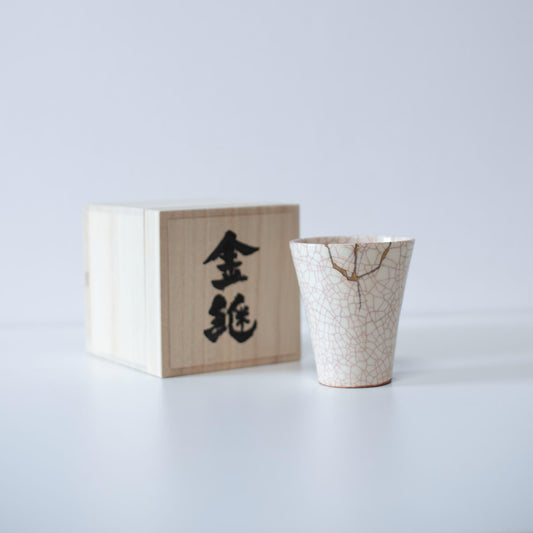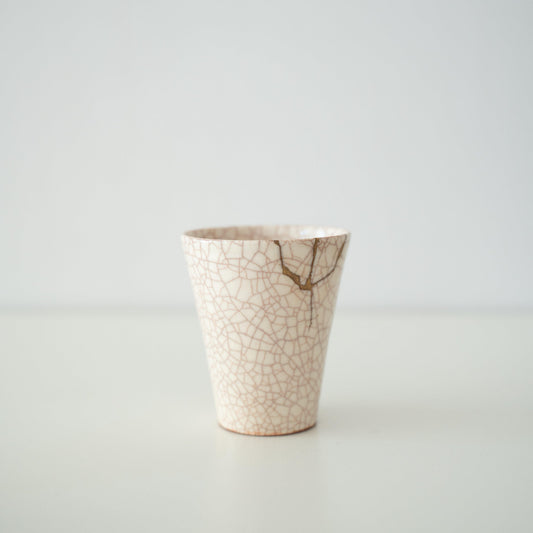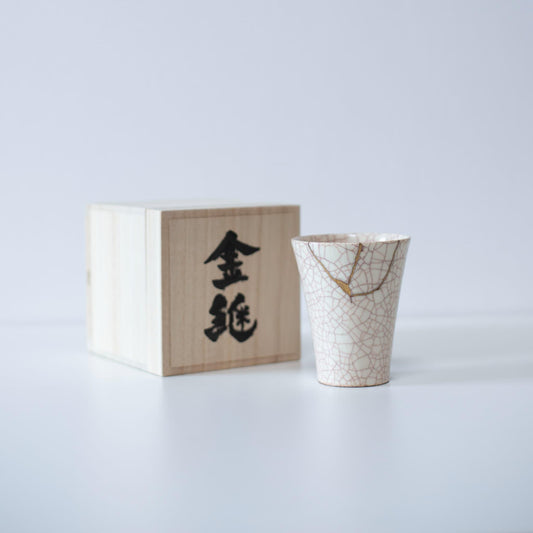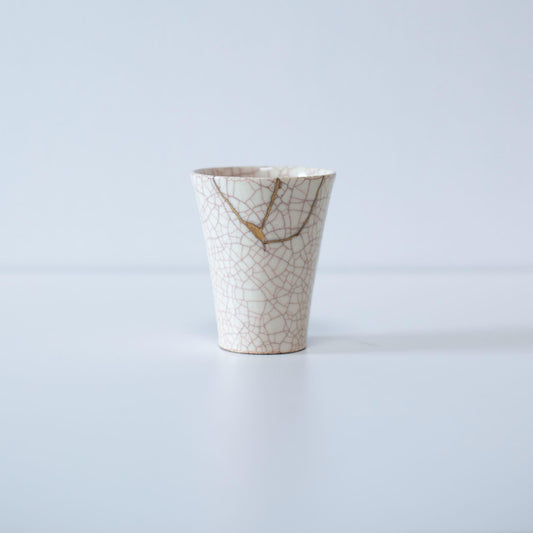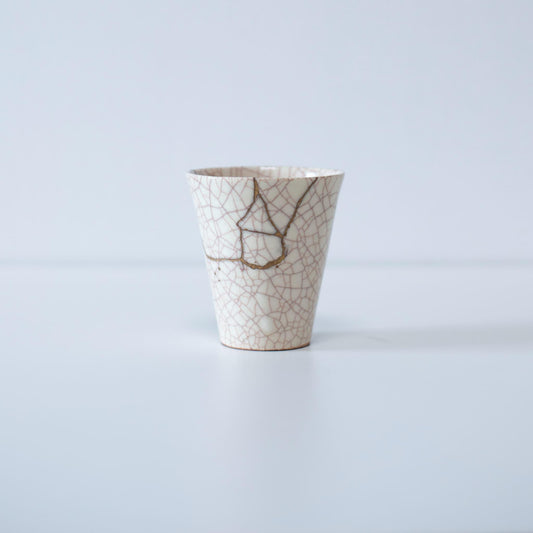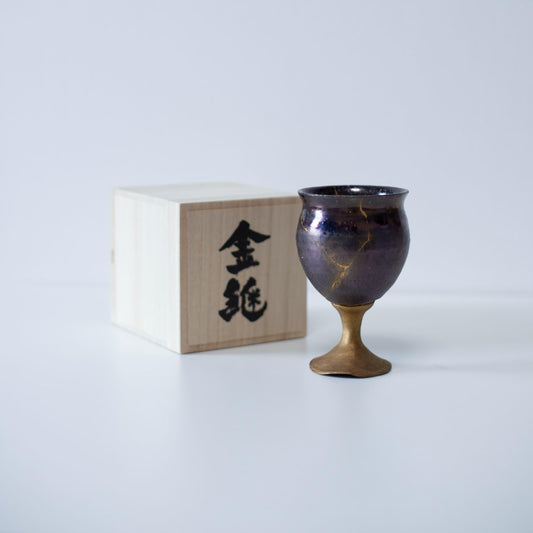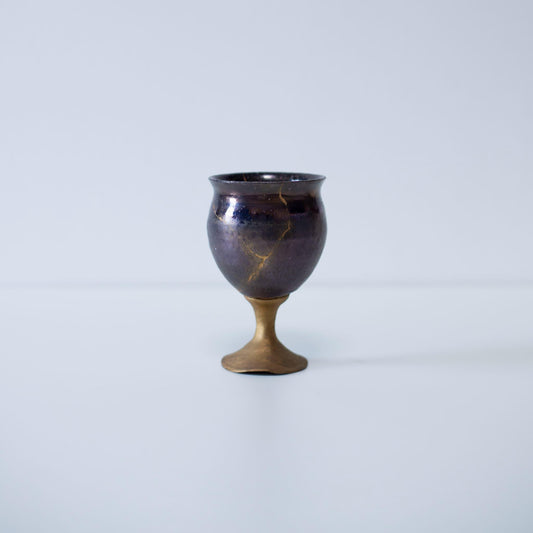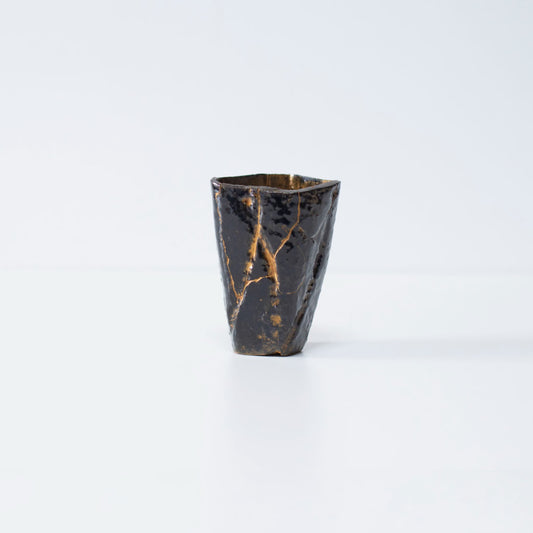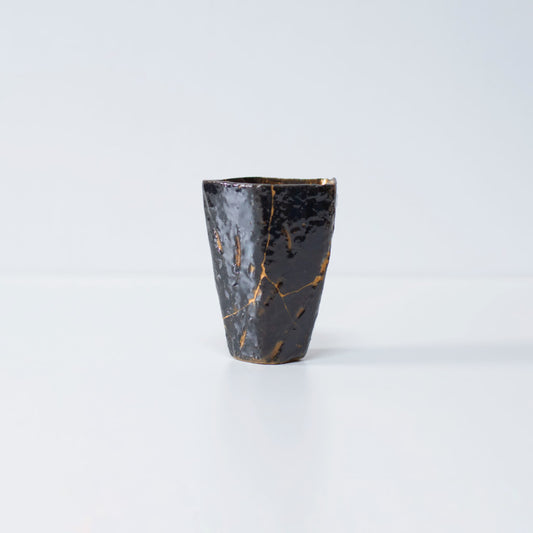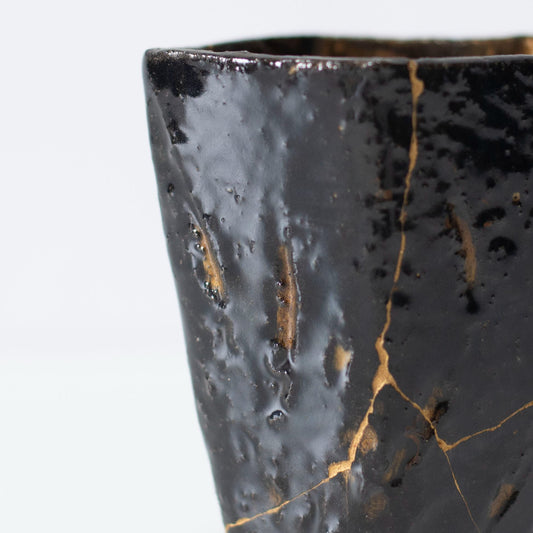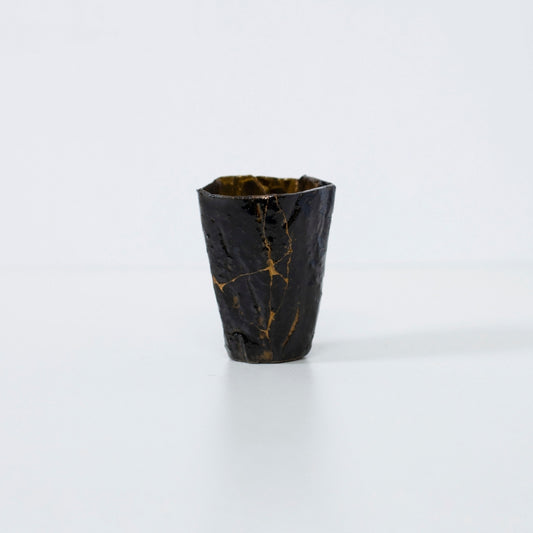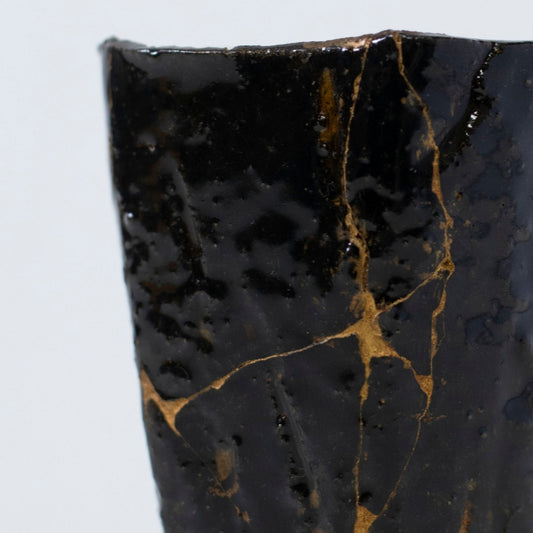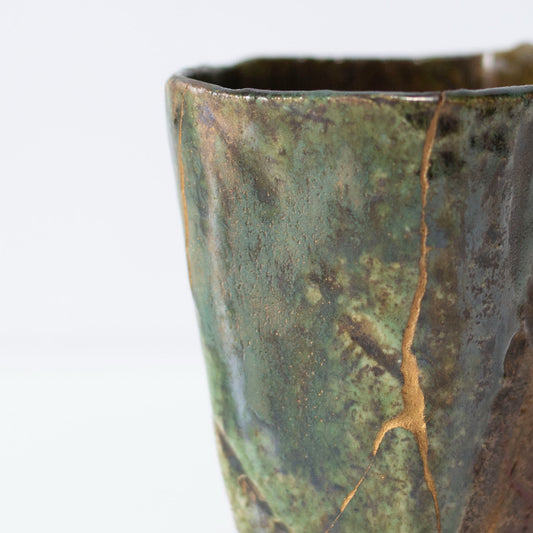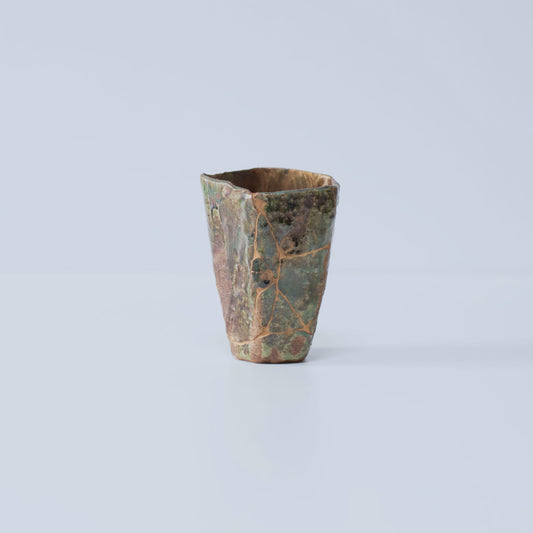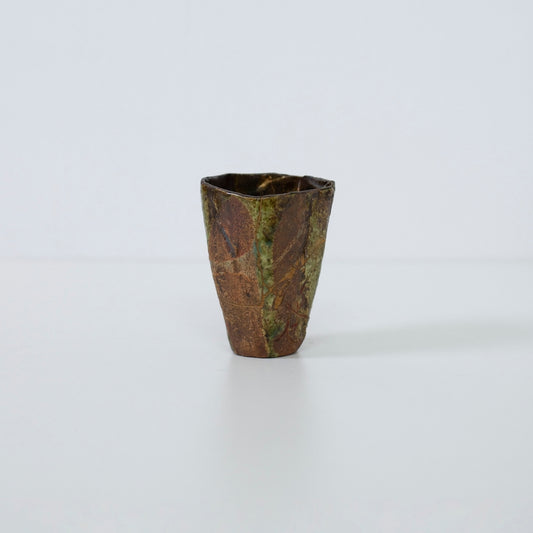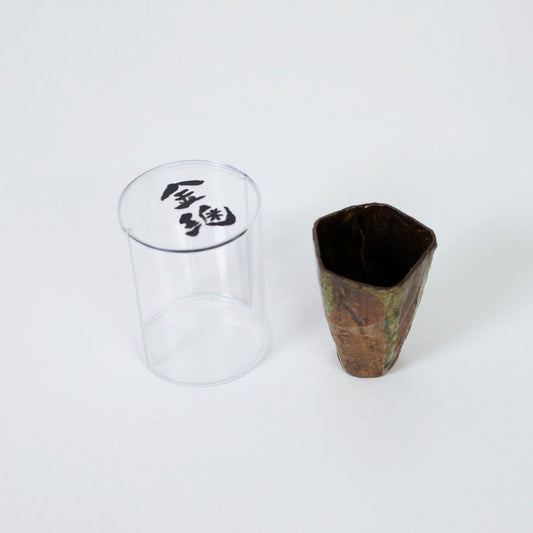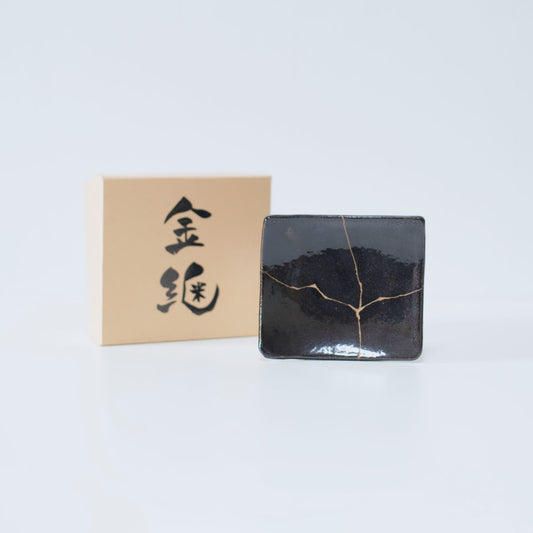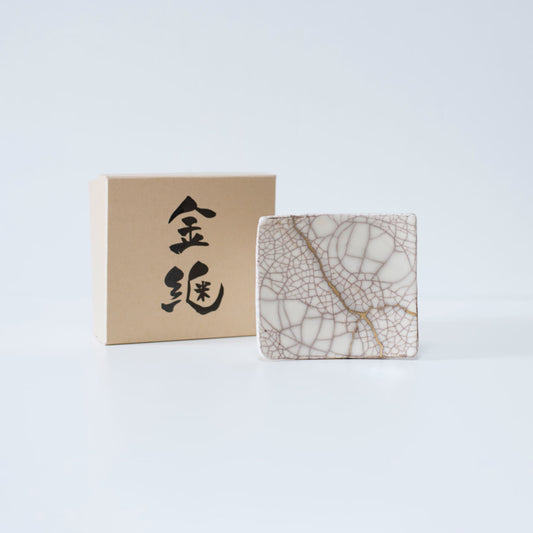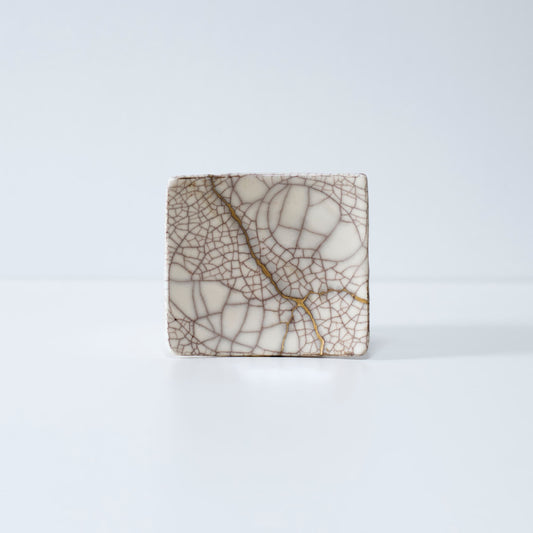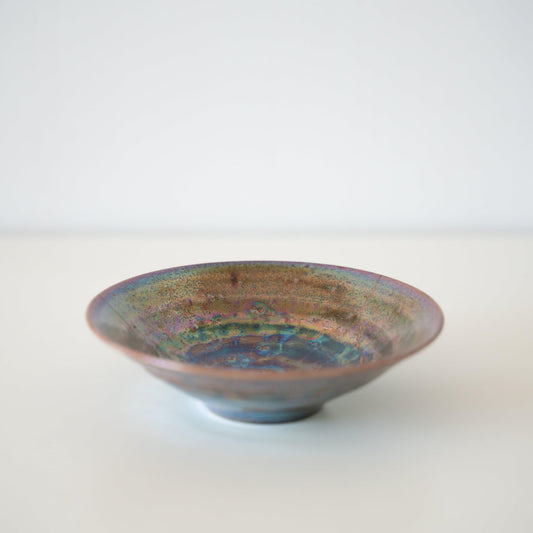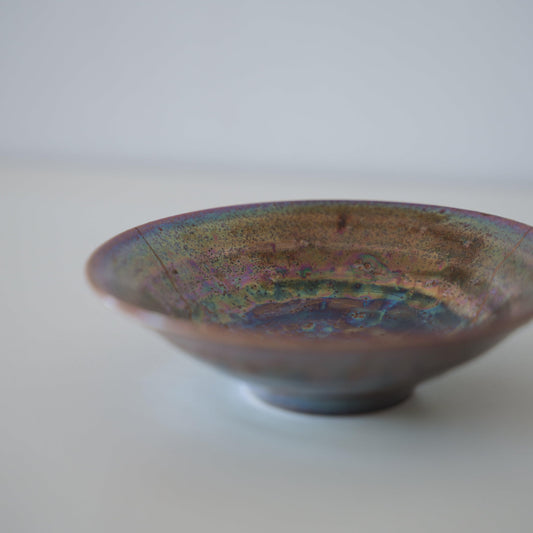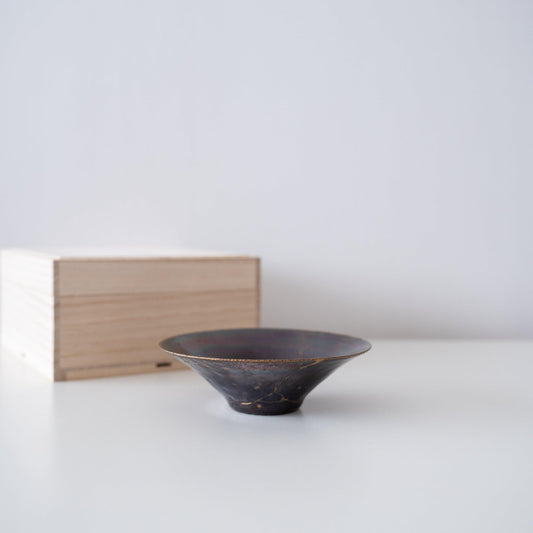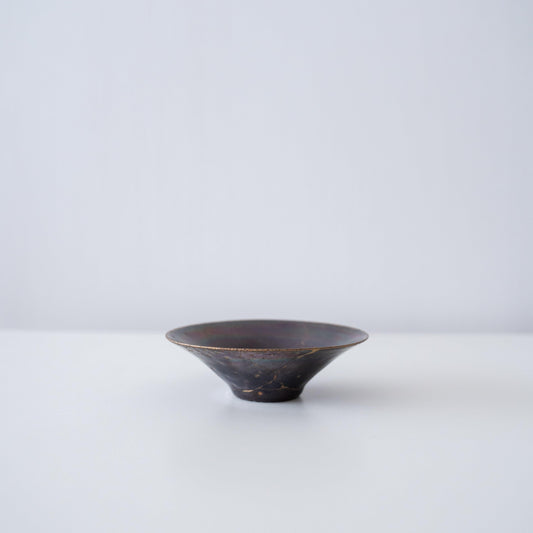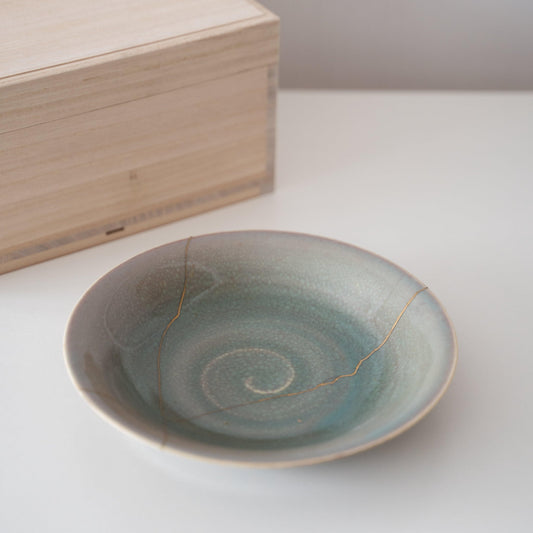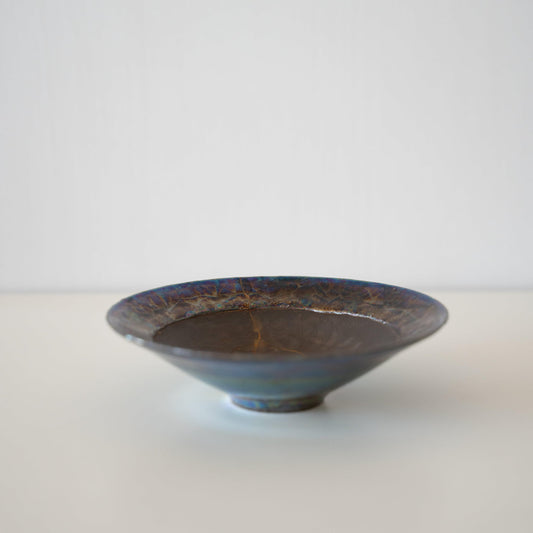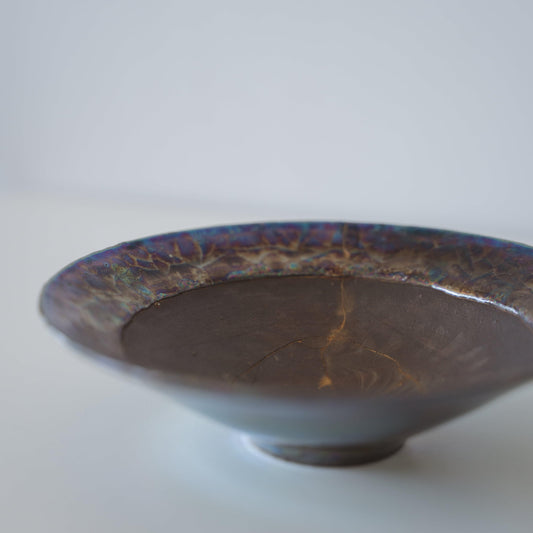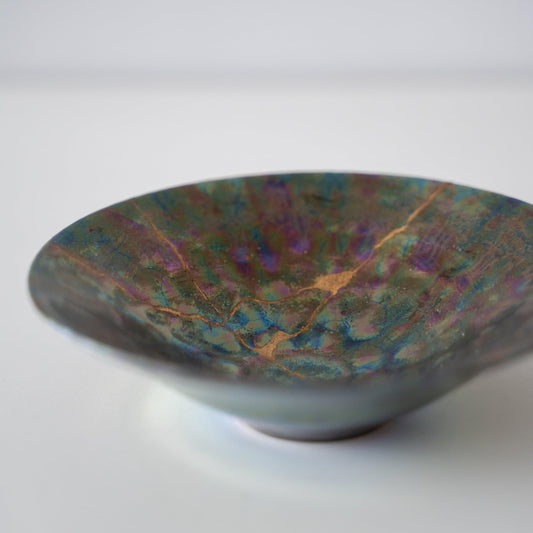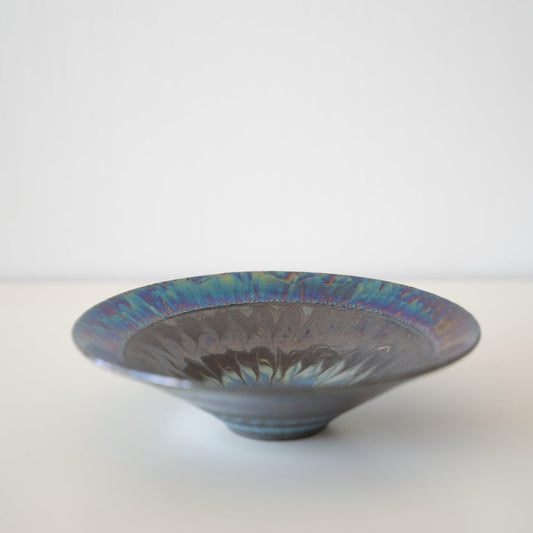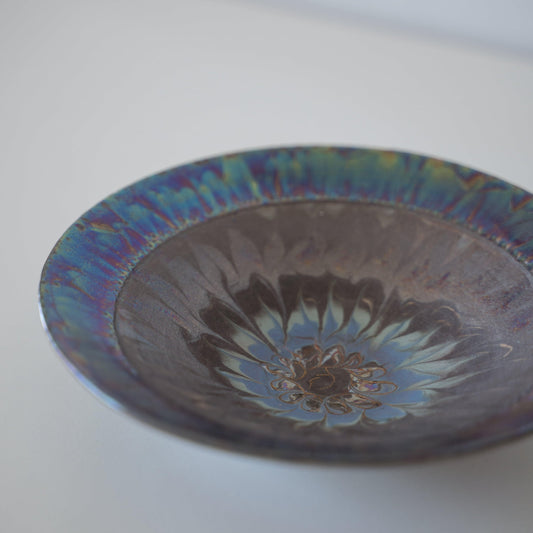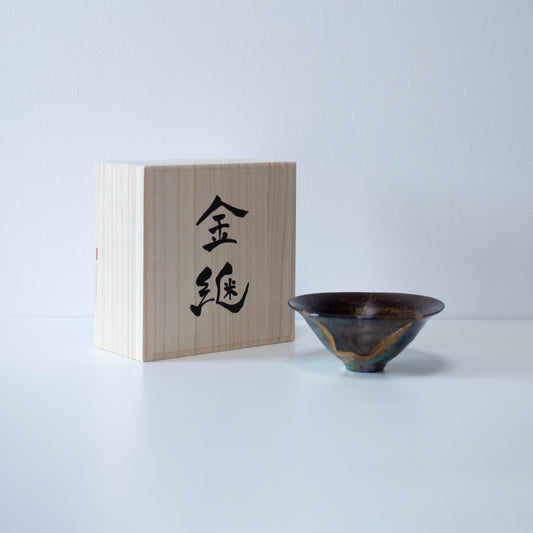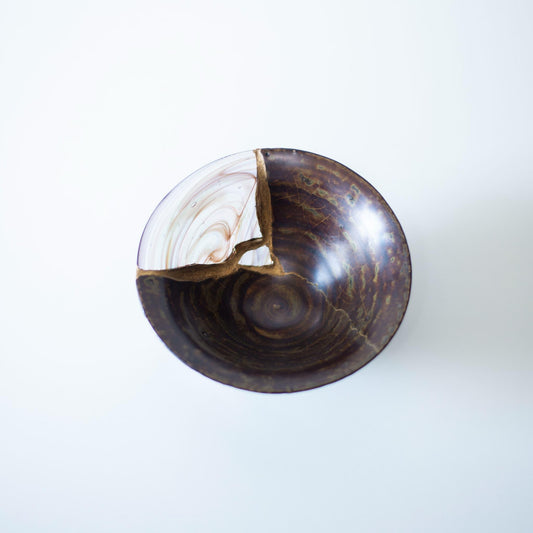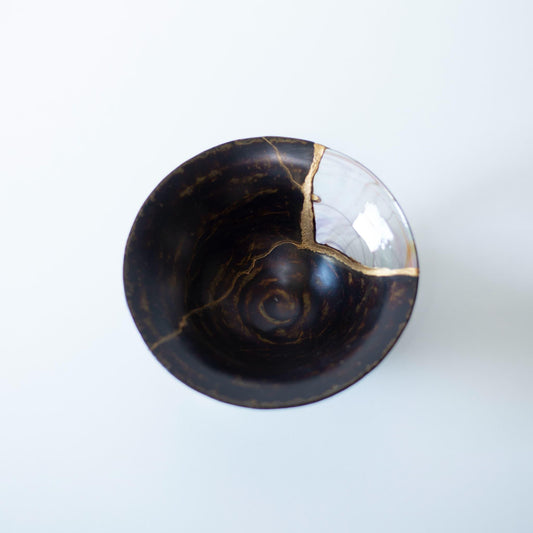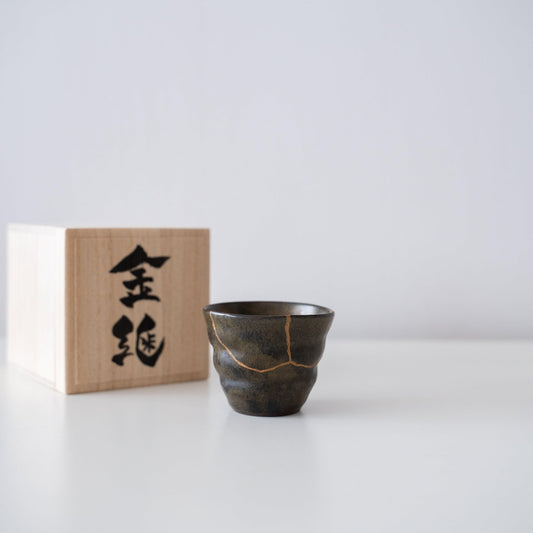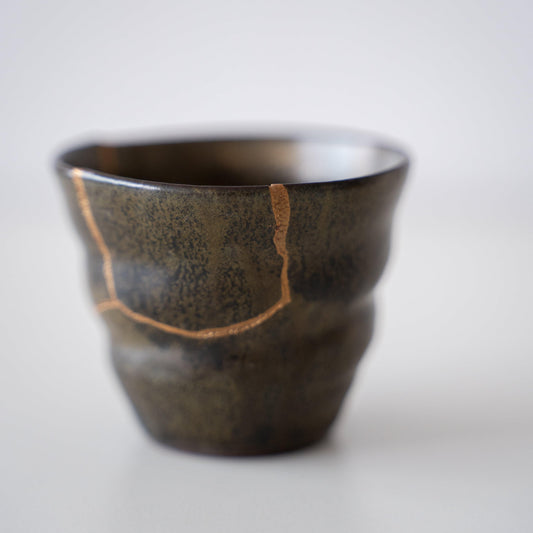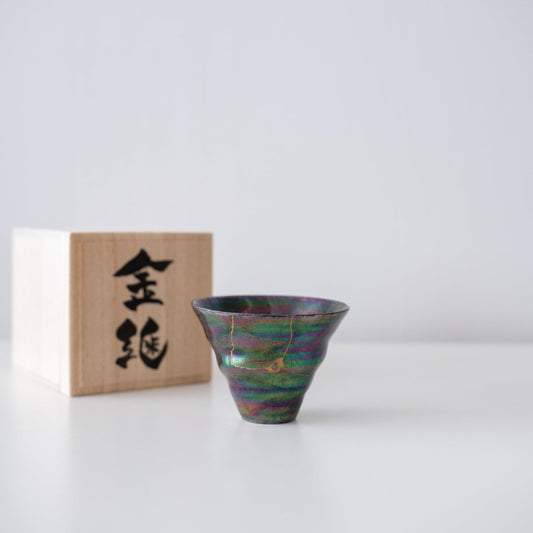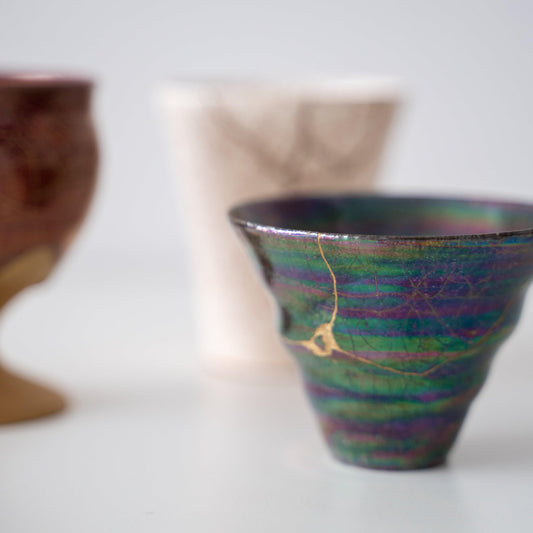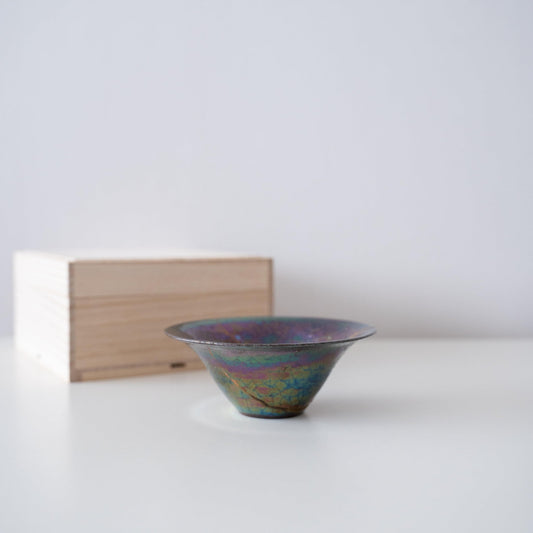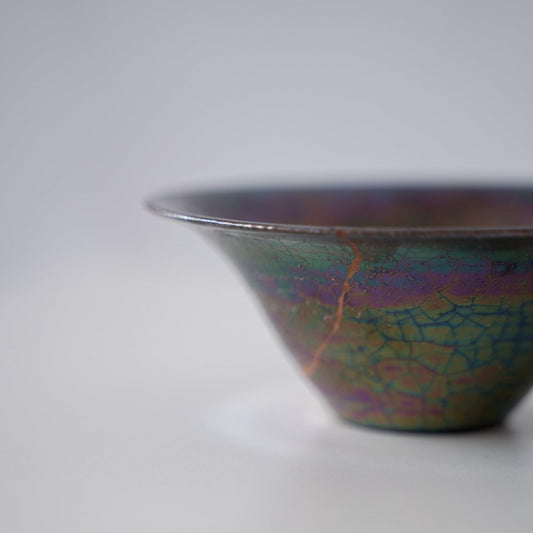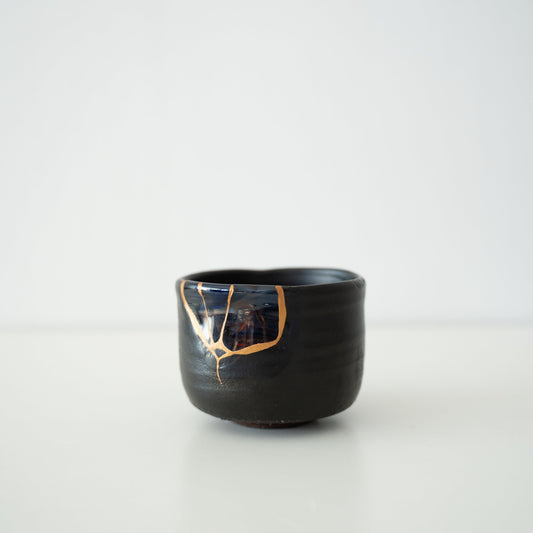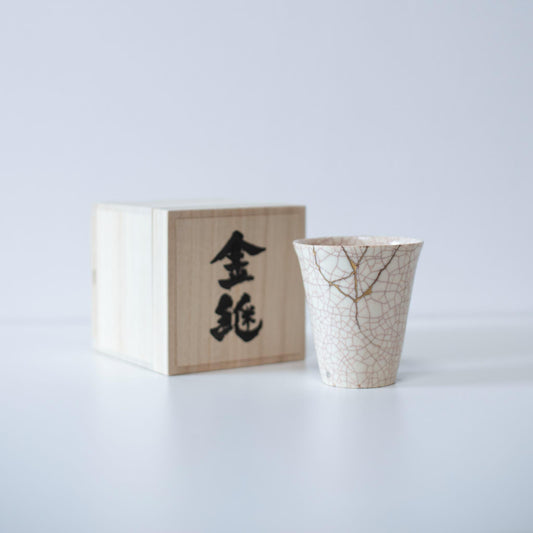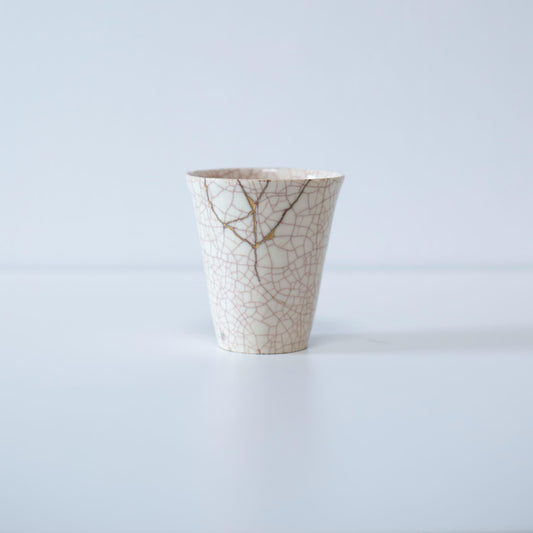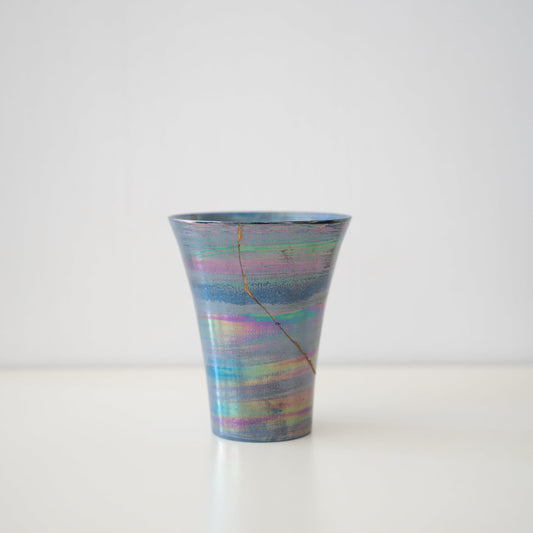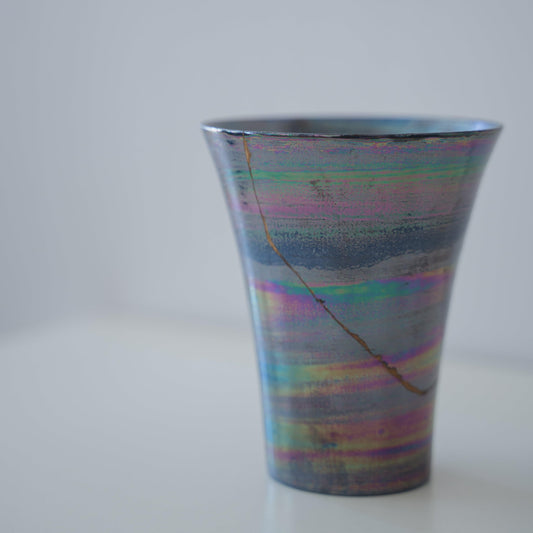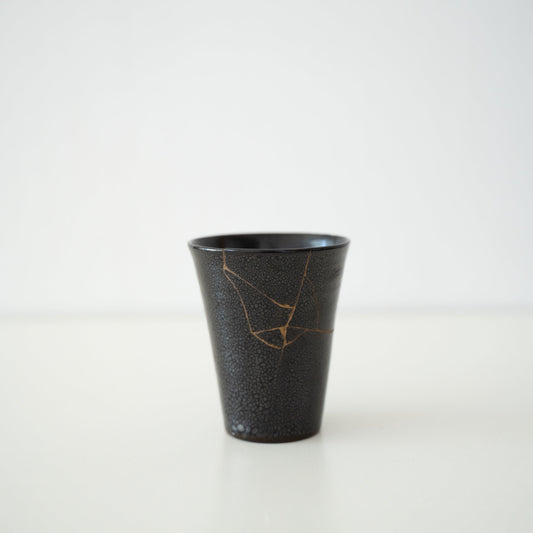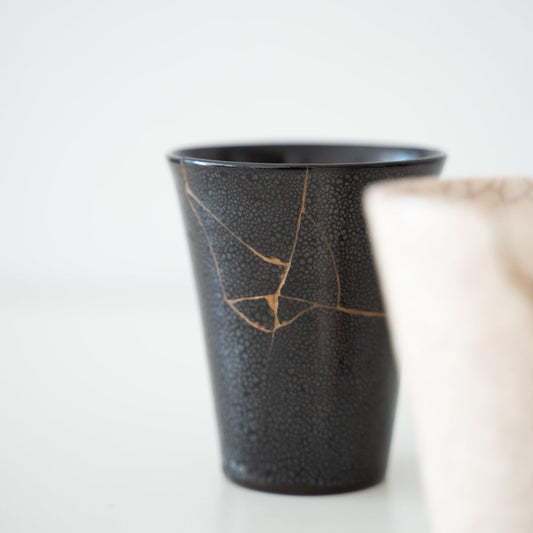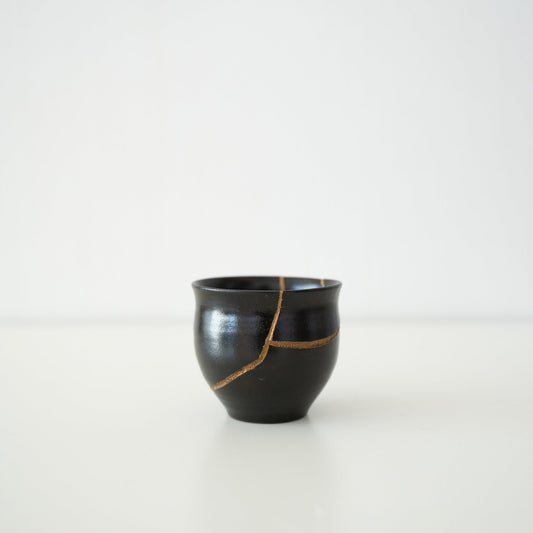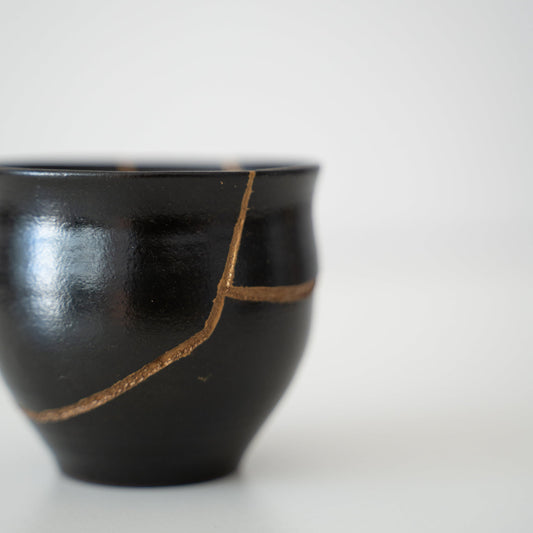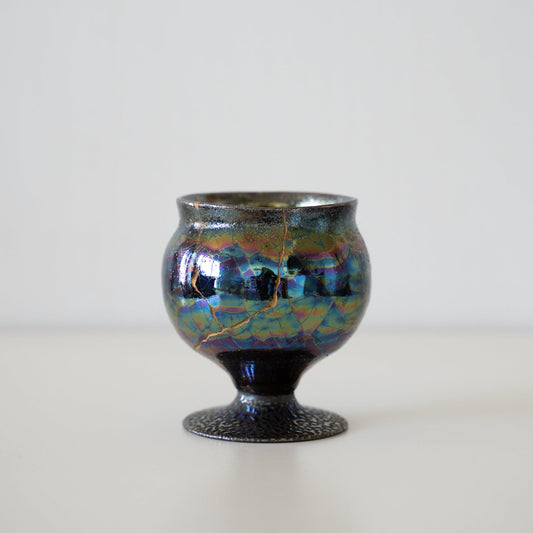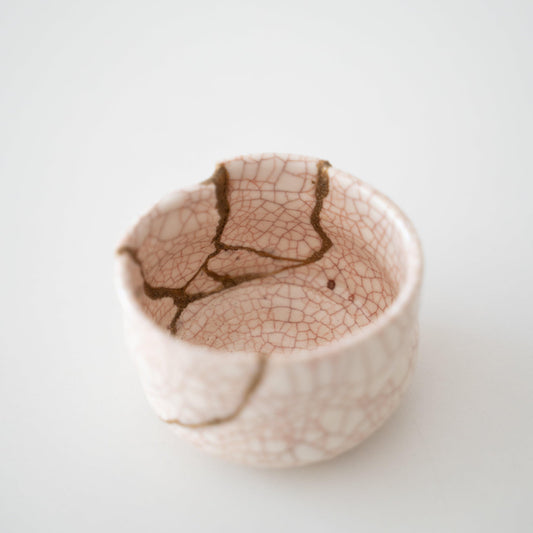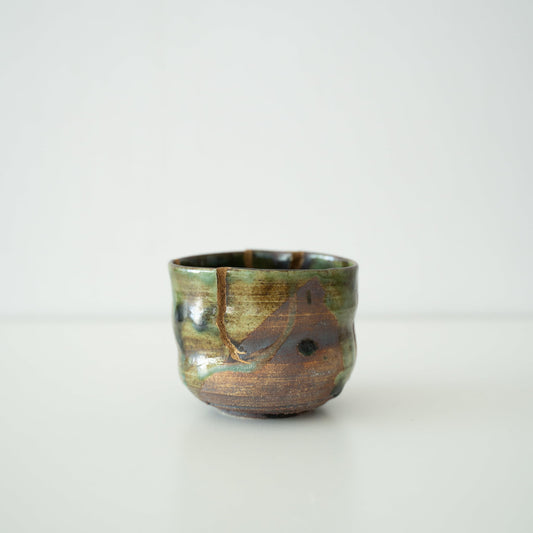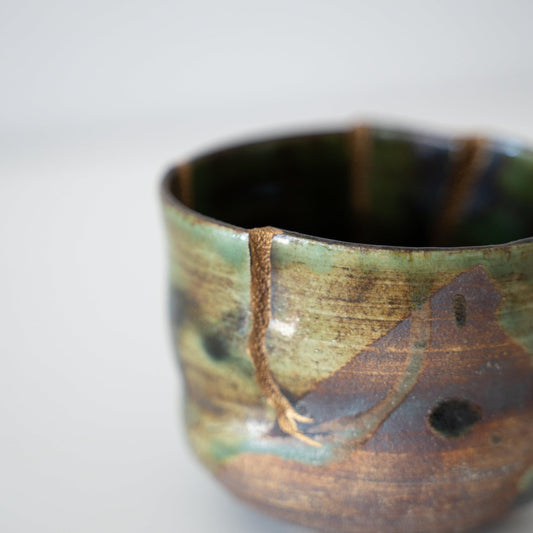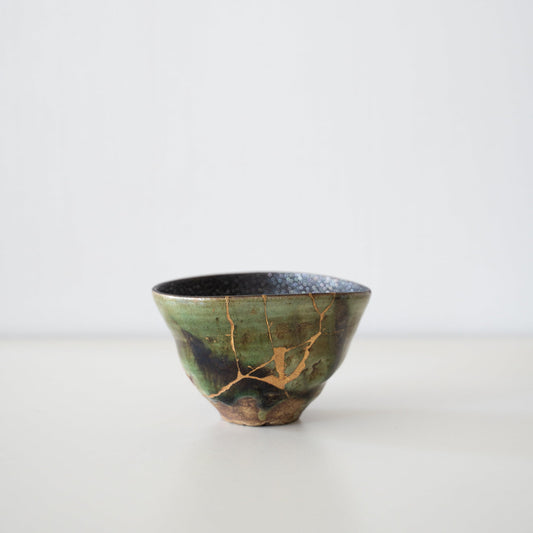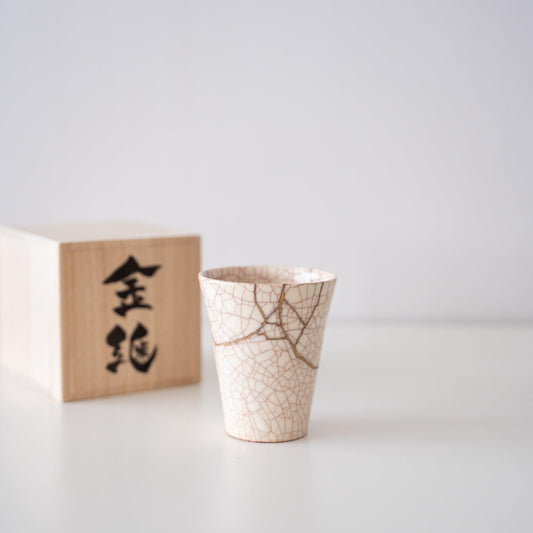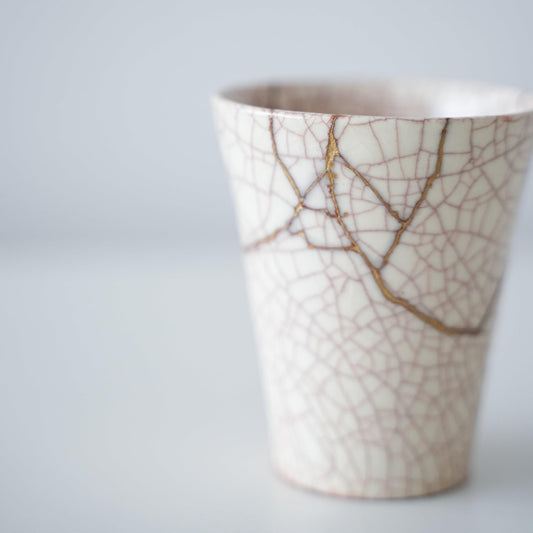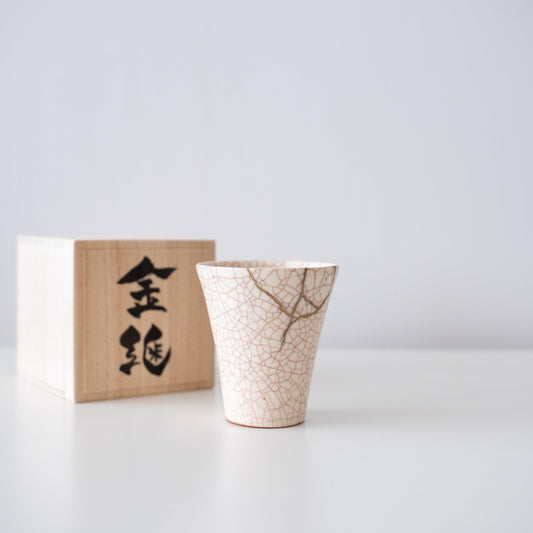Collection: Kintsugi Pottery
-
Kintsugi Cup "Vermilion Crackle" 01 with a Paulownia Wood Box
Regular price $360 USDRegular priceUnit price / per -
Kintsugi Cup "Vermilion Crackle" 05 with a Paulownia Wood Box
Regular price $360 USDRegular priceUnit price / per -
Kintsugi Cup "Vermilion Crackle" 06 with a Paulownia Wood Box
Regular price $360 USDRegular priceUnit price / per -
Kintsugi Wine Goblet "Magenta" with a Paulownia Wood Box
Regular price $420 USDRegular priceUnit price / per -
Pentagon Kintsugi Cup "Tenmoku" Black 01
Regular price $300 USDRegular priceUnit price / per -
Pentagon Kintsugi Cup "Tenmoku" Black 02
Regular price $300 USDRegular priceUnit price / per -
Pentagon Kintsugi Cup "Tenmoku" Black 03
Regular price $300 USDRegular priceUnit price / per -
Pentagon Kintsugi Cup "Oribe" Deep Green 01
Regular price $300 USDRegular priceUnit price / per -
Pentagon Kintsugi Cup "Oribe" Deep Green 02
Regular price $300 USDRegular priceUnit price / per -
Pentagon Kintsugi Cup "Oribe" Deep Green 03
Regular price $300 USDRegular priceUnit price / per -
Kintsugi Plate "Tenmoku" Black 01
Regular price $300 USDRegular priceUnit price / per -
Kintsugi Plate "Oribe" Deep Green 01
Regular price $300 USDRegular priceUnit price / per -
Kintsugi Plate "Oribe" Deep Green 02
Regular price $300 USDRegular priceUnit price / per -
Kintsugi Square Plate "Jet Black Lighting" 01
Regular price $500 USDRegular priceUnit price / per -
Kintsugi Square Plate "Vermilion Crackle" 01
Regular price $650 USDRegular priceUnit price / per -
Kintsugi Bowl "Supernova" with a Paulownia Wood Box
Regular price $440 USDRegular priceUnit price / per -
Kintsugi Bowl "Purple Nebula" 02 with a Paulownia Wood Box
Regular price $510 USDRegular priceUnit price / per -
Kintsugi Bowl "Four Color Yohenyu" with a Paulownia Wood Box
Regular price $650 USDRegular priceUnit price / per -
Kintsugi Bowl "Dark Nebula" with a Paulownia Wood Box
Regular price $660 USDRegular priceUnit price / per -
Kintsugi Bowl "Green Nebula" with a Paulownia Wood Box
Regular price $800 USDRegular priceUnit price / per -
Kintsugi Bowl "Blue Rose Nebula" with a Paulownia Wood Box
Regular price $960 USDRegular priceUnit price / per -
Kintsugi Bowl “Cherry Bark and Blue Moon” 02 with a Paulownia Wood Box
Regular price $1,650 USDRegular priceUnit price / per -
Kintsugi Bowl “Cherry Bark and Blue Moon” 01 with a Paulownia Wood Box
Regular price $1,850 USDRegular priceUnit price / per -
Kintsugi Sake Cup "Thunder Moss " with a Paulownia Wood Box
Regular price $420 USDRegular priceUnit price / per -
Kintsugi Sake Cup "Colored Clay Luster"
Regular price $510 USDRegular priceUnit price / per -
Kintsugi Bowl "Rainbow Luster" with a Paulownia Wood Box
Regular price $650 USDRegular priceUnit price / per -
Kintsugi Tea Bowl "Jet Black Lightning Orion" with a Paulownia Wood Box
Regular price $850 USDRegular priceUnit price / per -
Kintsugi Cup "Vermilion Crackle" 04 with a Paulownia Wood Box
Regular price $360 USDRegular priceUnit price / per -
Kintsugi Cup "Sirius" with a Paulownia Wood Box
Regular price $390 USDRegular priceUnit price / per -
Kintsugi Cup "Jet Black Lightning" with a Paulownia Wood Box
Regular price $360 USDRegular priceUnit price / per -
Kintsugi Sake Cup "Jet Black Lightning" with a Paulownia Wood Box
Regular price $410 USDRegular priceUnit price / per -
Kintsugi Goblet "The Dawn Starry Sky"
Regular price $440 USDRegular priceUnit price / per -
Kintsugi Tea Bowl "Vermilion Crackle"
Regular price $490 USDRegular priceUnit price / per -
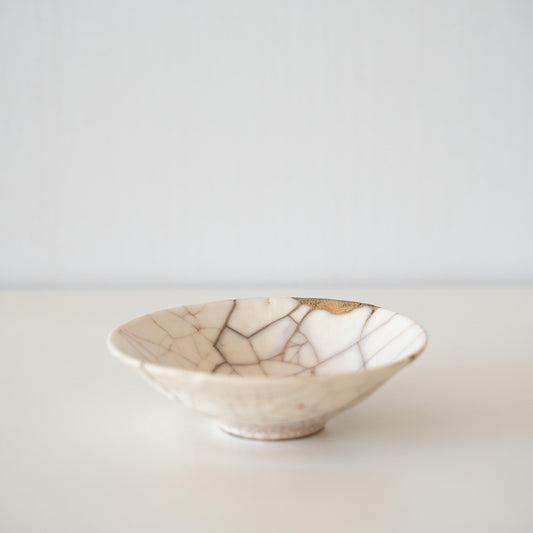
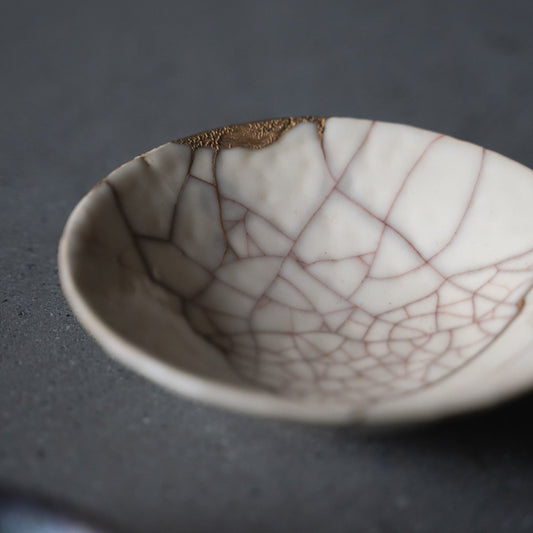 Sold out
Sold outKintsugi Bowl "Vermilion Crackle"
Regular price $440 USDRegular priceUnit price / per -
Kintsugi Tea Bowl "Deep Forest Oribe"
Regular price $959 USDRegular priceUnit price / per -
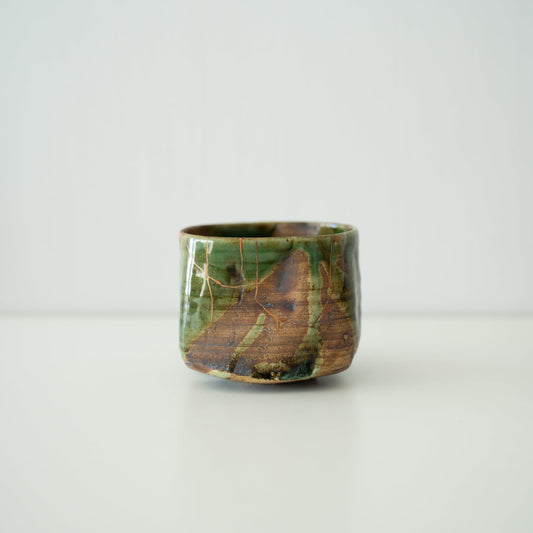
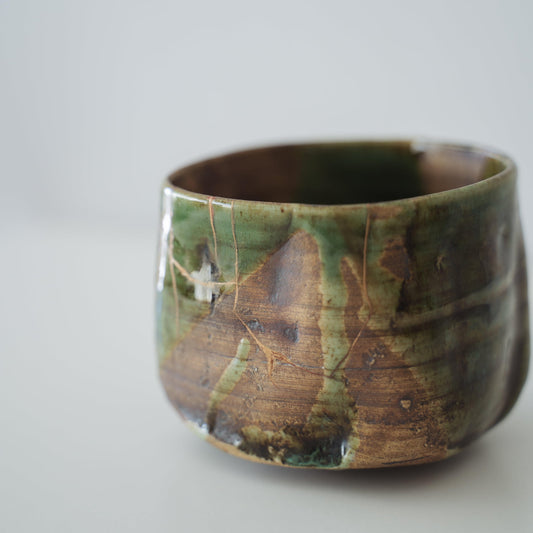 Sold out
Sold outKintsugi Tea Bowl "Valley Oribe"
Regular price $1,450 USDRegular priceUnit price / per -
Kintsugi Tea Bowl "Starry Sky and Valley"
Regular price $730 USDRegular priceUnit price / per -
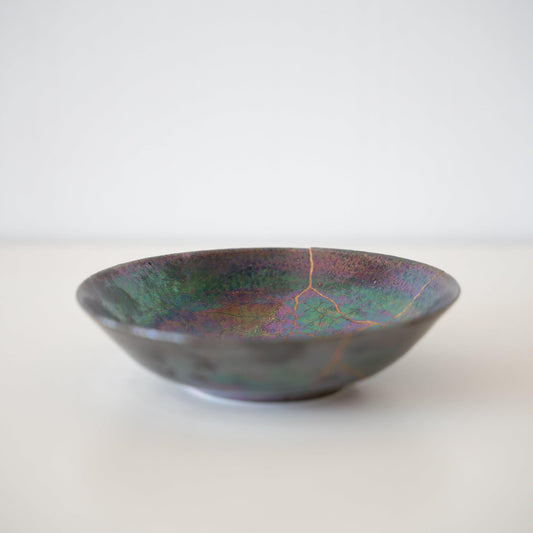
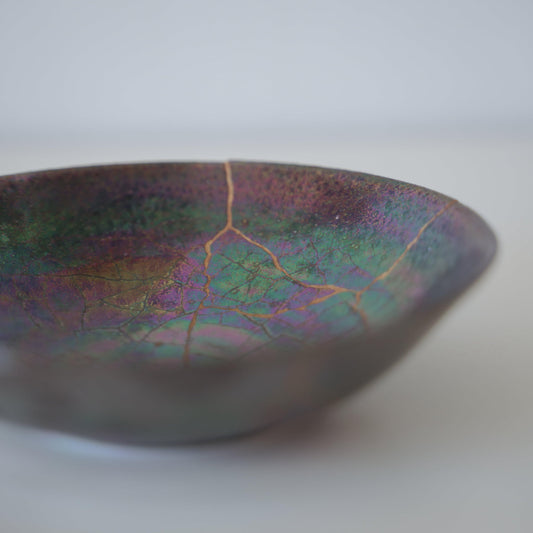 Sold out
Sold outKintsugi Bowl "Owl Nebula"
Regular price $440 USDRegular priceUnit price / per -
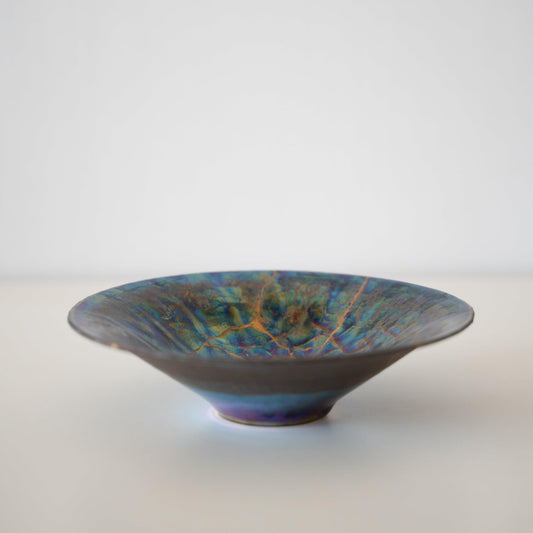
 Sold out
Sold outKintsugi Bowl "Blue Moon"
Regular price $1,320 USDRegular priceUnit price / per -
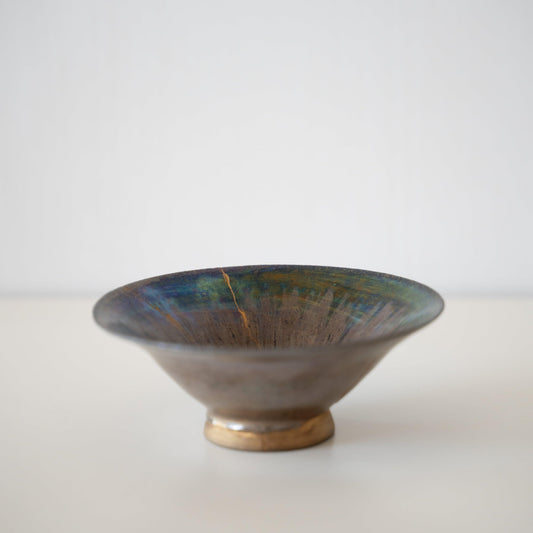
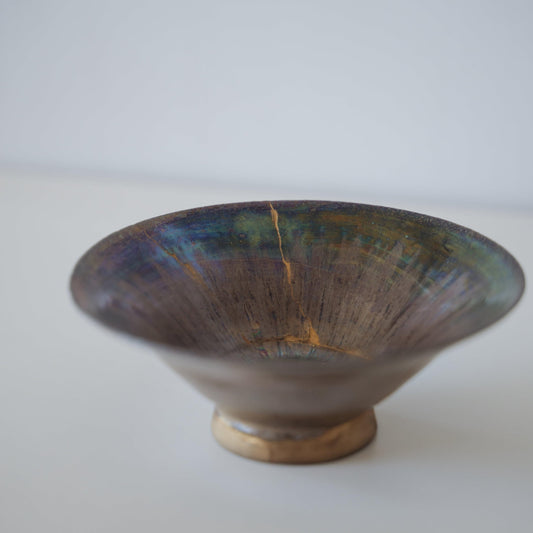 Sold out
Sold outKintsugi Bowl "Iris Rose"
Regular price $530 USDRegular priceUnit price / per -
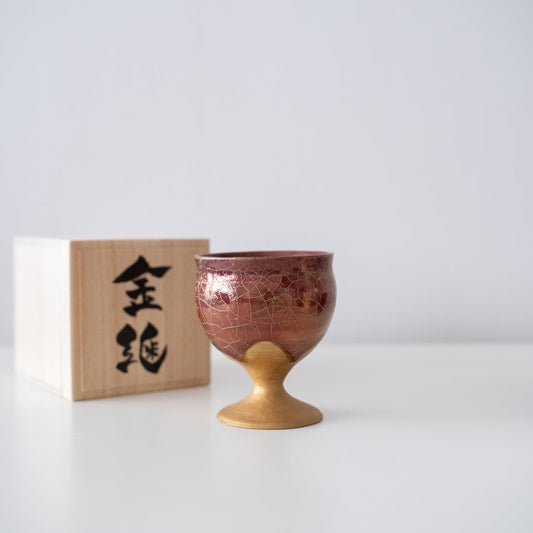
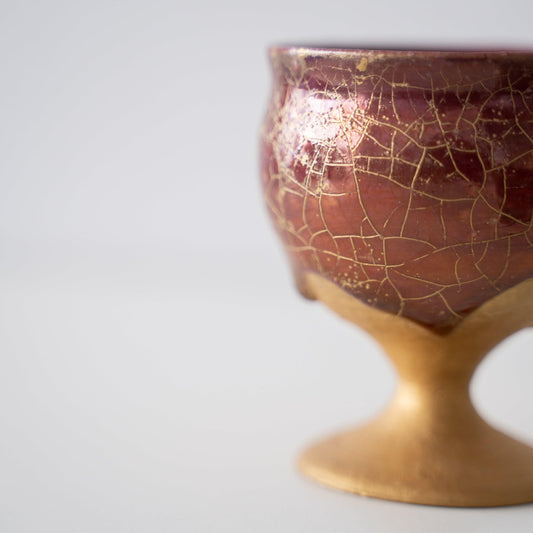 Sold out
Sold outKintsugi Goblet "Gold Clay Crackle"
Regular price $360 USDRegular priceUnit price / per -
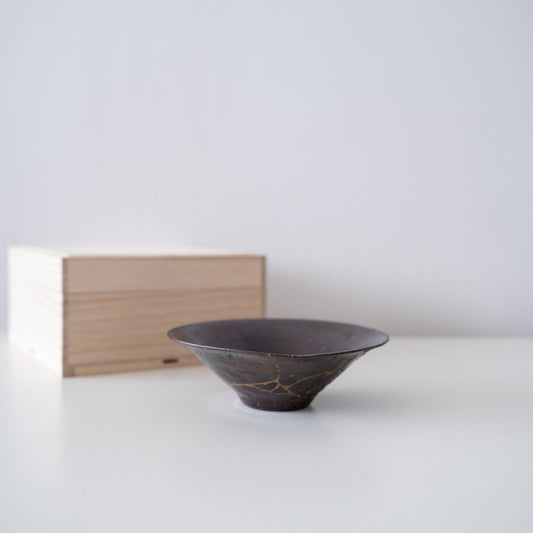
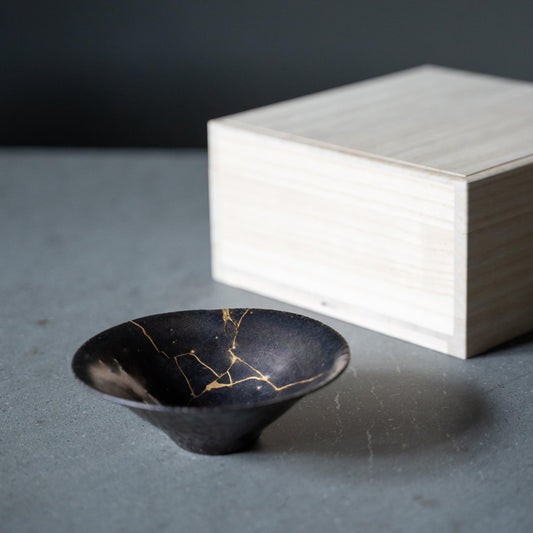 Sold out
Sold outKintsugi Bowl Purple Nebula 01
Regular price $650 USDRegular priceUnit price / per -
Kintsugi Cup "Vermilion Crackle" 02 with a Paulownia Wood Box
Regular price $360 USDRegular priceUnit price / per -
Kintsugi Cup "Vermilion Crackle" 03 with a Paulownia Wood Box
Regular price $360 USDRegular priceUnit price / per
Kintsugi Pottery Collections
-
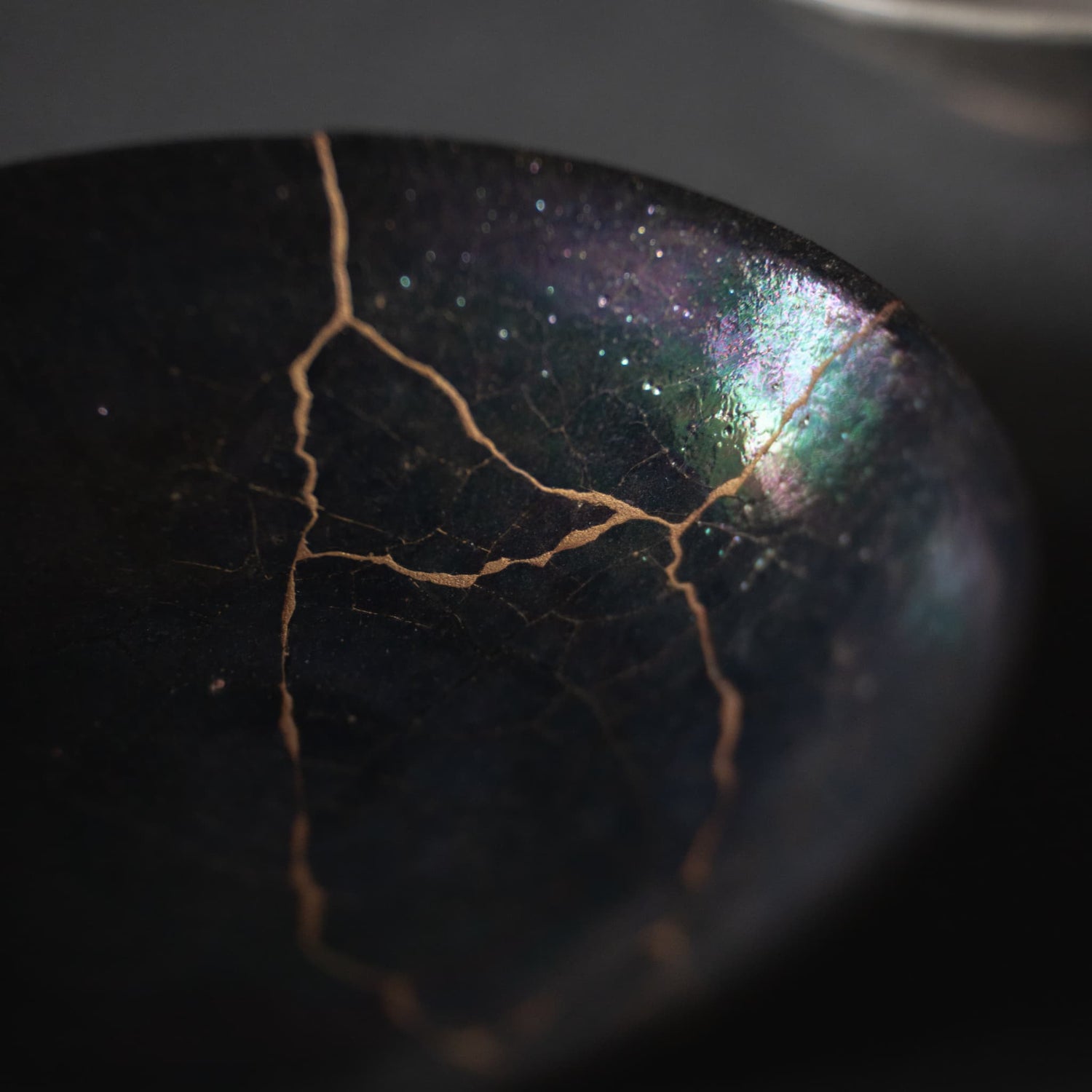
Kintsugi Bowls and Plates
Kintsugi Bowls and Plates Millennium Gallery Japan's Kintsugi bowl and plate collection...
-
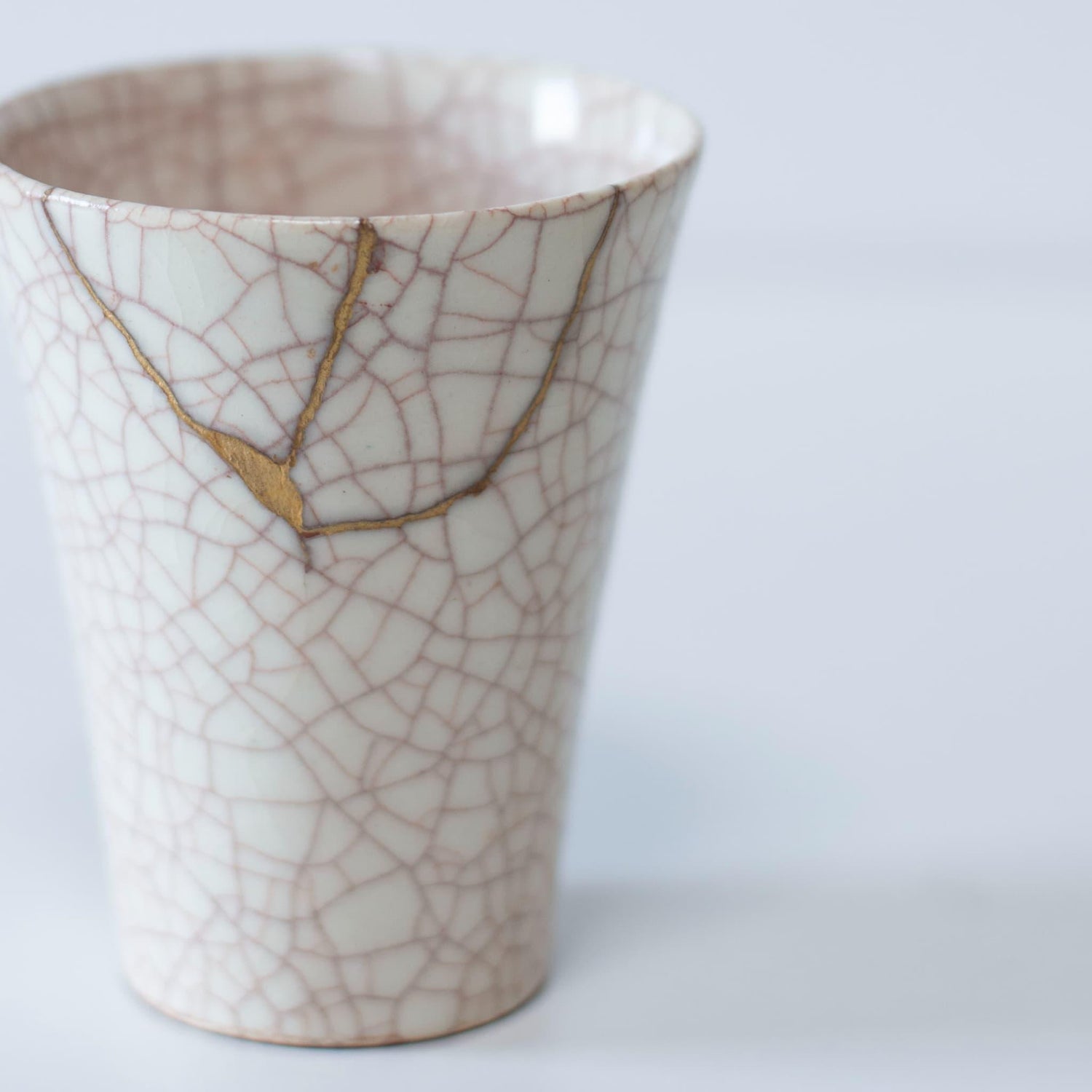
Kintsugi Cups
Kintsugi Cups Millennium Gallery Japan's Kintsugi art cup collection embodies the beauty...
Recently Viewed Products
Kintsugi Pottery
The aesthetics of Kintsugi, closely aligned with the Japanese philosophy of Wabi-Sabi, embraces cracks and wear as markers of time, encapsulating a unique beauty. This philosophy in kintsugi pottery views breaking and mending as essential parts of an object’s or a person’s history. Rather than concealing flaws, kintsugi art highlights them, celebrating them as symbols of resilience and beauty.
Kintsugi pottery is an ancient Japanese art form where broken ceramics are repaired with lacquer mixed or dusted with gold or silver, transforming fractures into visible expressions of value. This mindset is deeply rooted in Japan, a land often shaped by natural disasters, reflecting a resilient culture that views overcoming adversity as a means to gain strength and beauty. Today, the meaning of kintsugi transcends physical repair, symbolizing the triumph over mental and physical hardships in life.
Millennium Gallery Japan is the exclusive online store offering kintsugi pottery by Taku Nakano, a renowned master of kintsugi art. Nakano, who holds kintsugi workshops in English in Tokyo’s Omotesando, attracts visitors daily who wish to learn kintsugi or purchase his works. His kintsugi pieces, embodying resilience and beauty, make meaningful gifts for individuals who have overcome personal challenges.
Kintsugi: The Art of Golden Repair
What is Kintsugi?
Kintsugi is a traditional Japanese art of repairing broken ceramics with lacquer and decorating the cracks with gold or silver powder, giving the piece new life and value. This technique doesn't try to hide the damage but rather highlights it, emphasizing the history and story of the object. Kintsugi embodies the Japanese aesthetics of wabi-sabi, finding beauty in imperfection, and symbolizes the resilience cultivated by the Japanese people throughout their history of facing natural disasters like earthquakes and typhoons. Believed to have originated between the 1300s and 1500s, Kintsugi has been passed down through generations of Japanese artisans for nearly a millennium. Today, it is experiencing a resurgence of interest from artistic, sustainability, and mental health perspectives, with its meaning and philosophy resonating deeply with people worldwide.
Wabi-Sabi and Kintsugi
Kintsugi is deeply intertwined with the Japanese philosophy of "wabi-sabi". "Wabi" refers to the acceptance and appreciation of imperfection and flaws, while "sabi" signifies the beauty found in the passage of time and the patina of age. Kintsugi is not merely a technique for repairing ceramics with gold; it embodies the spirit of wabi-sabi, viewing the wear, cracks, and chips of an object not as defects but as signs of its history and a new kind of beauty. This philosophy, offering a profound message of resilience and self-acceptance, is the reason why Kintsugi holds a unique value in Japan, a country with over 200 traditional crafts with long histories.
Origins and History of Kintsugi
The origins of Kintsugi can be traced back to the 15th century, when the shogun Ashikaga Yoshimasa's favorite tea bowl was broken. Dissatisfied with the simple metal staples used to repair it, he inspired the creation of Kintsugi, transforming the damaged area into a visible decoration with lacquer and gold. This technique subsequently evolved in connection with the tea ceremony culture, giving rise to various Kintsugi methods and leading to the modern art of Kintsugi that symbolizes the spirit of "wabi-sabi".
Kintsugi and Disaster Recovery
Japan, with its rich natural environment, has experienced numerous natural disasters, including earthquakes and typhoons. Kintsugi, the traditional technique of repairing broken ceramics with lacquer and gold, breathing new life into them, has gained attention as a means of emotional healing and recovery support after disasters. After the Great East Japan Earthquake in 2011, workshops combining Kintsugi and post-traumatic growth (PTG) were used to support survivors. Similarly, after the 2024 Noto Peninsula earthquake, Kunio Nakamura, himself a victim of the disaster, offered free Kintsugi services to other survivors, combining support for the region's traditional industries with mental health care.
The Influence of Kintsugi in the Modern World
In the modern world, Kintsugi has transcended its role as a mere repair technique and established itself as an art form. Its philosophy and aesthetics have influenced artists worldwide, gaining attention as a new form of expression. Furthermore, Kintsugi, with its concept of creating new value through breakage and repair, connects with contemporary issues like sustainability, ensuring its continued relevance in the modern age. Its mention in the closing ceremony of the 2021 Paralympics further amplified its message, contributing to its global recognition as a culture that embraces and celebrates imperfection
The Meaning of Kintsugi
Recognizing the Beauty of Imperfection
In today's world, where perfection is often emphasized, Kintsugi offers a philosophy that accepts imperfection and highlights it as a unique characteristic and beauty of a person or object. Originating as a technique for repairing ceramics, Kintsugi transforms the golden lines created during the repair process into a testament to overcoming life's difficulties and trials, emphasizing the strength and beauty of the object. Finding beauty in imperfection, rather than striving for perfection, is the essence and philosophy of Kintsugi.
Acknowledging Scars as Symbols of Strength and Beauty
The gold decoration in Kintsugi repair doesn't conceal the scars but celebrates them as symbols of the object's history and resilience. This philosophy extends beyond objects to people's hearts, teaching the importance of embracing imperfections and finding strength in them. Kintsugi represents rebirth from a broken state, conveying a deeper message of resilience and self-acceptance: by accepting the past rather than denying it, one can gain new strength and beauty.
The Meaning of Gifting Kintsugi Pottery
A Blessing for Those Who Have Overcome Hardships
People from all over the world visit Taku Nakano's Omotesando workshop to purchase Kintsugi pieces as gifts for those who have overcome illness, injury, or hardship, or to symbolize reconciliation and deep bonds. Kintsugi works are ideal gifts of encouragement and blessing for those who have overcome illness or adversity. The unique beauty of each Kintsugi piece, with no two being alike, serves as a symbol of resilience and hope for the recipient.
A Celebration of the Strength and Resilience of Relationships
Kintsugi pieces, broken and then repaired to become even more beautiful, are also chosen as symbolic gifts to celebrate the strength and resilience of human relationships. They are given as gifts to commemorate the reconciliation of lovers, symbolize deep bonds, or mark the restoration of relationships with estranged individuals, making Kintsugi a gift that celebrates connections with loved ones.
Lacquer and the Kintsugi Process
About Lacquer
Lacquer is a refined sap extracted from the lacquer tree (Toxicodendron vernicifluum). Starting around June, when the sap becomes viscous, incisions are made in the tree trunk to collect it. In botanical terms, the lacquer tree is a deciduous broadleaf tree belonging to the Anacardiaceae family, native to the Japanese archipelago, mainland China, Southeast Asia, and other regions. While six species, including the Japanese wax tree, poison ivy, and Rhus javanica, grow naturally in Japan, only the lacquer tree produces sap suitable for lacquerware. Though lacquer trees were once cultivated throughout Japan for lacquer production, today, cultivation is concentrated in limited areas. Ninohe City in Iwate Prefecture is a key production center, responsible for about 75% of domestic lacquer production. This area focuses on increasing domestic lacquer production through cultivation, processing, and artisan development.
Properties of Lacquer
Lacquer mainly comprises a resinous component called urushiol, along with water, a rubbery substance, and an enzyme called laccase. When laccase interacts with oxygen from moisture in the air, it triggers a reaction in the urushiol, causing it to polymerize and transform from a liquid to a solid state. This is what we commonly refer to as lacquer "drying." However, unlike typical drying where moisture evaporates, lacquer "cures" by absorbing moisture, a unique characteristic. Usually, the surface hardens enough to be touched within a night, but the curing process continues gradually, with the lacquer becoming stronger over time. Fully cured lacquer is incredibly durable, heat-resistant, and unaffected by acids, alkalis, and salts. Its high water resistance, ability to prevent decay, and aesthetic qualities make it ideal for coating wooden products like bowls.
Main Types of Damage to Vessels
- Cracks (ware): When a vessel breaks but all the pieces remain, this is referred to as a "crack." The broken edges of the fragments are joined with lacquer to restore the original shape. Cracks may also involve chips or hairline cracks, requiring corresponding repair techniques.
- Hairline cracks (hibi): A "hairline crack" is a crack that hasn't caused the vessel to break apart but may leak. A "nyu" is a fine line that could potentially develop into a crack with continued use, even if it doesn't currently leak. In both cases, lacquer cannot be applied directly to the broken surface. Instead, diluted lacquer is carefully seeped into the crack to seal it.
- Chips (kake): A "chip" occurs when a part of the vessel breaks off and the fragment is missing. "Hotsure" refers to a small chipped area on the rim of the vessel. In both scenarios, the damaged portion is filled and shaped to restore the vessel.
The Kintsugi Process and Tools
Kintsugi involves different repair methods depending on the type of damage – "crack," "hairline crack," or "chip." Each type of damage has about ten specific repair methods and pre-treatments. Following these, the piece undergoes multiple stages of decorative finishing and meticulous polishing to achieve the final result. The kintsugi process is intricate and varies based on the damage. Therefore, a diverse range of tools is employed, including brushes, spatulas, cutter knives and carving tools for refining the surface, and specialized tools for applying gold or silver powder.
The Art of Kintsugi and the World of Taku Nakano
Kintsugi, a traditional Japanese restoration technique, is an art that repairs broken pottery and glass with lacquer and precious metals, giving them new beauty. This technique goes beyond mere restoration, symbolizing the "wabi-sabi" aesthetic of accepting imperfection and the "mottainai" spirit of not wasting resources. Taku Nakano, a kintsugi artist based in Omotesando, Tokyo, is reviving this art form in the modern age and garnering international attention.
Unique Works Born from Rare Materials and Exceptional Skill
Nakano's kintsugi works are created using rare materials such as pure gold, platinum, natural lacquer, and his own hand-blown glass. This elevates the act of repair to an art form, transforming broken pottery into upcycled works that harmonize with contemporary lifestyles. His pieces embody the kintsugi philosophy of "becoming stronger and more beautiful than before breaking," and his works featuring starry skies and celestial bodies convey a universal message of life's harmony and regeneration.
A Globally Recognized Ambassador of Kintsugi Culture
Nakano's work is highly regarded both domestically and internationally. Notably, his restoration of a Georgian wine vessel, commissioned by the Georgian government, was exhibited at Tennozu Isle and garnered attention as a symbol of the fusion of kintsugi and Georgian wine cultures. The Nihon Keizai Shimbun newspaper described this as a "global movement bringing a new wave to traditional crafts." His works have also been highly praised at overseas exhibitions, expanding the potential of kintsugi culture internationally.
Sharing Philosophy Through Kintsugi
Nakano is also dedicated to education, having taught kintsugi techniques to over 2,000 students. The workshops held at his Omotesando studio offer participants the opportunity to not only learn the techniques but also to reflect on life's renewal and the essence of beauty through the process of repairing broken vessels. This experience provides emotional healing for many participants and allows them to experience the philosophy of finding new value in broken objects.
Choosing Kintsugi Pottery
Types of Kintsugi Pottery
Kintsugi can be applied to various ceramics, including tea bowls, plates, cups, and vases. Choosing the right piece according to its shape and purpose allows you to find the perfect gift. As Kintsugi is originally a repair technique, genuine Kintsugi ware repaired by true Kintsugi artisans is very rare on the market, making it extremely difficult to find Kintsugi ceramics for gifts or display even in Japan.
Types of Kintsugi Techniques
There are various Kintsugi techniques, including "hibikintsugi" for repairing cracks, "kakekintsugi" for filling chips, and "yobitsugi" for joining different fragments. "Yobitsugi," in particular, requires high skill and increases the value of the piece as an artwork. Understanding which repair technique was used on a Kintsugi piece is also important for appreciating it fully.
The Price of Kintsugi Pottery
The price of a Kintsugi piece varies depending on the materials used, the technique employed, and the artist's skill. Works using genuine lacquer and gold are particularly rare and highly valued for their beauty and worth. The type and size of the ceramic and the Kintsugi technique used also influence the price. Generally, larger Kintsugi pieces like bowls and plates are more expensive than smaller ones like cups. Similarly, Kintsugi using advanced techniques like "yobitsugi" tends to be more expensive than simpler techniques like "hibikintsugi" or "kakekintsugi".
Millennium Gallery Japan handles the works of Taku Nakano, who has been entrusted with the restoration of precious ceramics by various governments and conveys the philosophy of hope and resilience to people worldwide. His works, available exclusively at Millennium Gallery Japan, are authentic Kintsugi art pieces created by breaking and then repairing ceramics using genuine Kintsugi techniques. Although limited in quantity, these pieces make heartfelt gifts to celebrate life's milestones or honor those who have overcome adversity.
Kintsugi is a magnificent expression of Japanese tradition and aesthetics. Its message of embracing imperfection and finding beauty within it continues to resonate strongly today. We invite you to experience the beauty of Japan and the richness of this profound philosophy through the art of Kintsugi.

